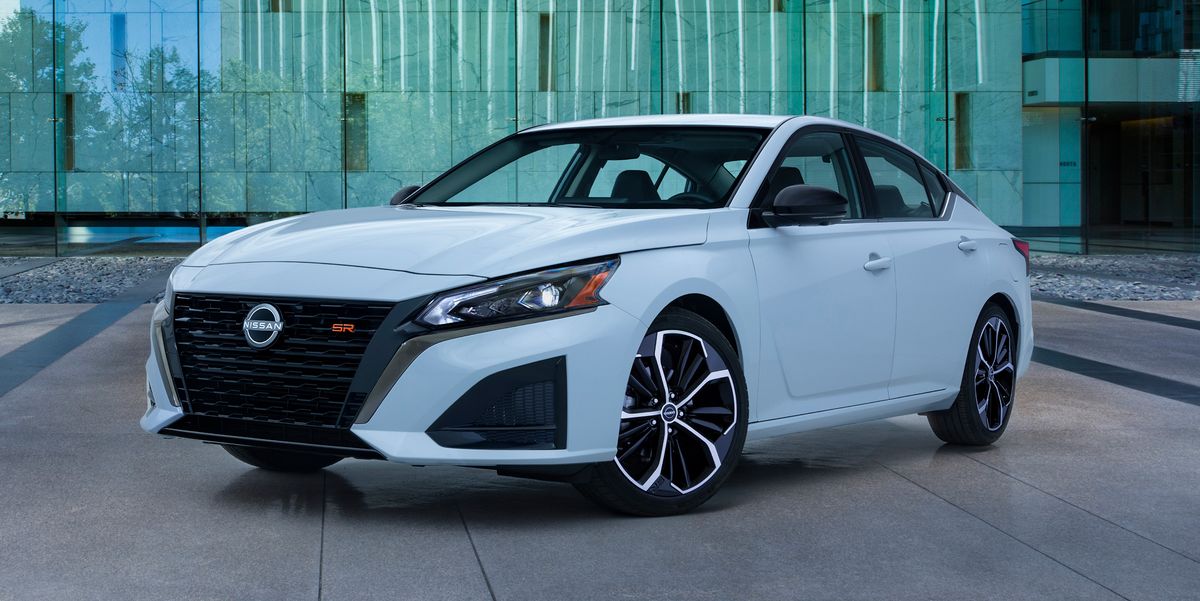2023 Nissan Altima

Overview
The 2023 Nissan Altima is a perfectly adequate family sedan with sharp looks, a spacious cabin, and available all-wheel drive. For power, the Altima has two different four-cylinder engines to choose from: a 182-hp base engine or a turbocharged variable-compression unit with 248 horsepower. However, that’s as far as the Altima pushes the envelope. No matter how you spec it, it comes with a continuously variable automatic transmission (CVT) and delivers a drive that’s more polite than perky. With an EPA-estimated 39 mpg for highway driving, though, the Altima is impressively fuel efficient for a non-hybrid vehicle. A roomy interior, comfortable seating, an optional 12.3-inch infotainment screen, and a solid offering of standard safety features make this sedan easy to live with—even if it lacks the soulfulness of the Honda Accord or the refinement of the Toyota Camry.
What’s New for 2023?
Nissan updates the Altima’s appearance for 2023 with new wheels, a redesigned front fascia with new LED headlights and the automaker’s new logo. There are two new paint options as well: Gray Sky Pearl and Garnett Pearl Metallic. Besides these minor visual tweaks, the top Platinum trim level has been renamed SL. The inside of the Altima gets a new 12.3-inch infotainment touchscreen that comes standard on SL and SR models, but is available for SV as optional equipment. Nissan has expanded the standard safety features within its Safety Shield 360 driver-assistance technology. New standard safety gear includes automatic emergency braking with pedestrian detection, rear automatic braking, lane departure warning, blind spot warning, rear cross traffic alert, and high-beam assist.
Pricing and Which One to Buy
S
$26,200 (est)
SV
$27,200 (est)
$28,200 (est)
SL
$36,000 (est)
Unlike the Accord and Hyundai Sonata, the Altima offers two features they don’t: all-wheel drive and that unique VC-Turbo engine. While the benefits of the latter are hard to quantify, the $1400 all-wheel-drive system might attract sedan shoppers who live in the Snowbelt. Still, we’d choose the SR trim level and skip both options. Along with a sport-tuned suspension and 19-inch wheels that make this family sedan more fun to drive, the SR has a host of desirable features that include an eight-way power driver’s seat, Apple CarPlay and Android Auto, an upgraded digital gauge cluster, a leather-wrapped steering wheel, and more. We’d also spring for the Premium package that adds heated mirrors, heated front seats, and a sunroof.
Engine, Transmission, and Performance
The Altima has a standard 188-hp 2.5-liter four-cylinder engine that pairs with a continuously variable automatic transmission (CVT). The optional turbocharged 2.0-liter four-cylinder makes up to 248 horsepower with premium fuel and also uses a CVT. While Nissan touts the innovative variable-compression technology, only the 2.5-liter engine can be had with all-wheel drive. The standard four-cylinder engine and all-wheel drive had predictable, albeit unremarkable, acceleration. The engine grew noisier the harder we pressed the gas pedal, but the four-cylinder Camry we tested was equally loud at times. The VC-Turbo engine makes the Altima significantly quicker. Despite the unconventional turbocharged engine and uncommon all-wheel drive, the Nissan is not as fun to drive as the Accord. The Altima SR receives a sport-tuned suspension and 19-inch wheels that make it more entertaining on twisty sections of road. However, these upgrades also reduce the ride quality found on regular Altima models. Surprisingly, the top-of-the-line SL (formerly known as Platinum) model we drove had more cornering grip than the 2019 BMW 330i xDrive we tested. The Nissan also had a comfortable ride that prevented any shudders over undulating pavement. Its steering system was precise by family-sedan standards and doesn’t add effort to emulate steering feel. The Altima’s brake pedal had linear feedback and prompt responses to our input.
More on the Altima sedan
Fuel Economy and Real-World MPG
The Altima doesn’t offer a fuel-saving hybrid or eco-friendly plug-in-hybrid model as do many of its rivals, but its two gasoline engines have lofty fuel-economy ratings and even better real-world results. When equipped with front-wheel drive, the base 2.5-liter four-cylinder engine gets an EPA-estimated 28 mpg city and 39 highway. With all-wheel drive, those EPA estimates drop to 26 mpg city and 36 mpg on the highway. The turbocharged 2.0-liter gets an EPA estimated 25 mpg city and 34 mpg on the highway. On our 75-mph highway fuel-economy route—part of our extensive testing regimen—the all-wheel-drive Altima achieved an impressive 41 mpg; the VC-Turbo version recorded a notable 37 mpg. The most fuel-efficient (nonhybrid) Accord and Camry earned 38 mpg and 45 mpg, respectively.
For more information about the Altima’s fuel economy, visit the EPA’s website.
Interior, Comfort, and Cargo
Inside, the Altima’s cabin provides a straightforward dashboard with user-friendly switchgear. Interior materials vary among trim levels, but everything is a significant improvement compared with the previous-generation Altima. Our SV test vehicle had attractive appointments and hard plastics that drew little attention. The flat-bottomed steering wheel and faux carbon fiber were a bit much here, especially since there are no paddle shifters or selectable drive modes on the SV. Still, the soft armrests made cruising and sitting in traffic more tolerable. The front seats can accommodate a wide variety of body types, but we felt that the lumbar support was too aggressive. The large back seats were very comfortable with ample legroom. We fit six carry-on bags in the Altima’s trunk and 17 bags total with the rear seats folded. These numbers matched those of the Camry we tested, but both fell short of the Accord’s 19 bags. Unfortunately, the Nissan’s rear seats don’t fold completely flat and they must be released using handles in the trunk, which is inconvenient. The Altima has decent storage in the front seat, with narrow albeit deep door pockets and a useful tray at the front of the center console.
The Car and Driver Difference
Infotainment and Connectivity
The Altima’s standard 8.0-inch touchscreen has Apple CarPlay and Android Auto capability. The infotainment interface has a customizable main menu but otherwise few personalization options. While the sound system has useful knobs for volume and tuning, the touchscreen we tested responded slowly to inputs. Altima SL and SR get a 12.3-inch touchscreen with navigation, wireless phone charging, and WiFi hotspot standard. The bigger screen is optional on SV models.
How to Buy and Maintain a Car
Safety and Driver-Assistance Features
Every Altima has forward-collision warning and automated emergency braking, blind-spot monitoring, high-beam assist, rear cross-traffic alert, and more. Nissan also offers a semi-autonomous drive mode called ProPilot Assist.
For more information about the Altima’s crash-test results, visit the National Highway Traffic Safety Administration (NHTSA) and Insurance Institute for Highway Safety (IIHS) websites. Key safety features include:
Standard lane-departure warning with available lane-keeping assist Standard rear automated emergency braking Available adaptive cruise control
Warranty and Maintenance Coverage
The Altima has a competitive warranty coverage that aligns with rivals such as the Accord and Camry. Unfortunately, Nissan doesn’t offer any complimentary scheduled maintenance—Toyota provides two years or 25,000 miles.
Limited warranty covers three years or 36,000 miles Powertrain warranty covers five years or 60,000 miles No complimentary scheduled maintenance
Specifications
Specifications
2020 Nissan Altima 2.5 SR AWD
VEHICLE TYPE
front-engine, all-wheel-drive, 5-passenger, 4-door sedan
PRICE AS TESTED
$30,720 (base price: $27,945)
ENGINE TYPE
DOHC 16-valve inline-4, aluminum block and head, direct fuel injection
Displacement
152 cu in, 2488 cc
Power
182 hp @ 6000 rpm
Torque
178 lb-ft @ 3600 rpm
TRANSMISSION
continuously variable automatic
CHASSIS
Suspension (F/R): struts/multilink
Brakes (F/R): 11.7-in vented disc/11.0-in disc
Tires: Hankook Kinergy GT, 235/40R-19 92V M+S
DIMENSIONS
Wheelbase: 111.2 in
Length: 192.9 in
Width: 72.9 in
Height: 57.4 in
Passenger volume: 101 cu ft
Trunk volume: 15 cu ft
Curb weight: 3429 lb
C/D TEST RESULTS
Rollout, 1 ft: 0.3 sec
60 mph: 7.4 sec
100 mph: 19.7 sec
110 mph: 25.3 sec
Rolling start, 5–60 mph: 8.3 sec
Top gear, 30–50 mph: 4.8 sec
Top gear, 50–70 mph: 5.6 sec
1/4 mile: 15.8 sec @ 91 mph
Top speed (governor limited): 119 mph
Braking, 70–0 mph: 176 ft
Roadholding, 300-ft-dia skidpad: 0.91 g
C/D FUEL ECONOMY
Observed: 31 mpg
EPA FUEL ECONOMY
Combined/city/highway: 29/25/35 mpg
More Features and Specs



